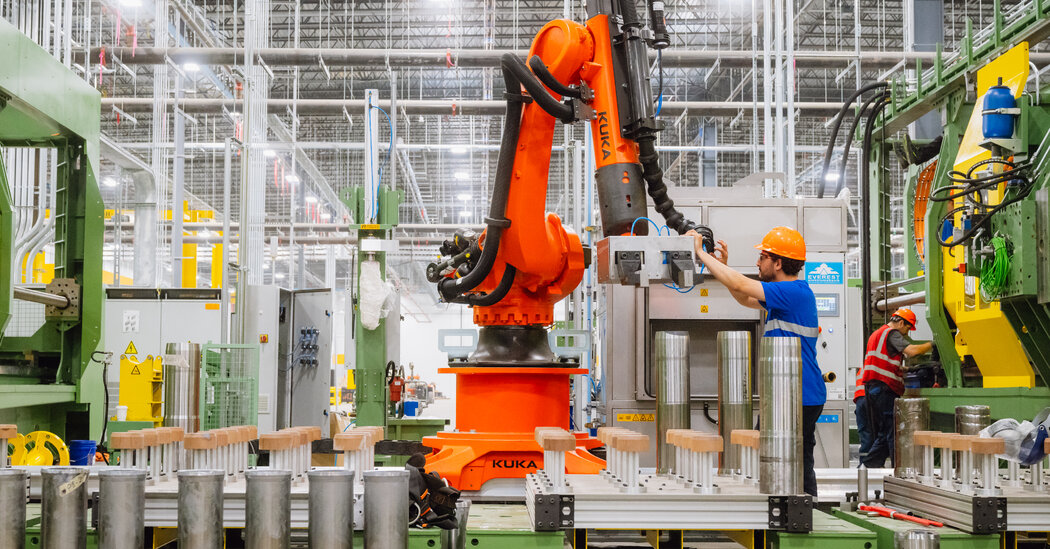In a warehouse off Lyndon B. Johnson Freeway in an industrial area outside Dallas, the future of American military ammunition production is coming online.
Here, in the Pentagon’s first new major arms plant built since Russia invaded Ukraine, Turkish workers in orange hard hats are busy unpacking wood crates stenciled with the name Repkon, a defense company based in Istanbul, and assembling computer-controlled robots and lathes.
The factory will soon turn out about 30,000 steel shells every month for the 155-millimeter howitzers that have become crucial to Kyiv’s war effort.
. . .
To keep Ukraine’s artillery crews supplied, the Pentagon set a production target last year of 100,000 shells per month by the end of 2025. Factories in Scranton and Wilkes-Barre, Pa., together make about 36,000 shells per month. The new General Dynamics facility in Mesquite, Texas, will make 30,000 each month once it reaches its full capacity.
The factory will soon turn out about 30,000 steel shells every month for the 155-millimeter howitzers
Love it. Ukraine needs the artillery shells, and that is one place the US and Europe are vastly short on production.
Ukraine’s effort heavily relies on artillery, which accounts for a substantial portion of battlefield casualties. Ukrainian forces require around 75,000 artillery shells per month just to hold their current positions, and potentially double that amount for offensive operations. In contrast, Russia is capable of firing approximately 300,000 shells monthly, supported by both domestic production and imports from North Korea.
Interestingly, South Korea has also become a key player in supplying artillery ammo, agreeing to transfer 300,000 155mm shells to the U.S., which in turn helped replenish stocks sent to Ukraine in 2023.
Can South Korean 105-Millimeter Ammunition Rescue Ukraine?.
How weapons from Western allies are strengthening Ukraine’s defence against Russia.
How’s the crap nork arty ammo doing?
Adequately for the crappy old Soviet artillery the Russians have.
But isn’t it unethical to import weapons from North Korea? 🙃
Fudge, I’m never getting large rifle primers again…
Google Shopping indexes pretty much everything where people sell something online. I bet that someone has them.
searches
These guys have an indexed entry.
https://www.bobcatarmament.com/ginex-large-rifle-primers-nickel-5000ct.html?source=googlebase
5000ct/$670.19/Excl. tax/In stock
EDIT: These guys appear to have lower prices:
https://republicammunition.com/product-category/primers/rifle-primers/
Huh, neat
This is the best summary I could come up with:
Here, in the Pentagon’s first new major arms plant built since Russia invaded Ukraine, Turkish workers in orange hard hats are busy unpacking wood crates stenciled with the name Repkon, a defense company based in Istanbul, and assembling computer-controlled robots and lathes.
“Despite all our starts and stops with the government, the continuing resolutions and getting the last supplemental, the industrial base responds when you fund it and it’s done right,” William A. LaPlante, the Pentagon’s top acquisition official, said in an interview with his Army counterpart, Douglas R. Bush.
Half of the on-site American work force came from another General Dynamics plant about 10 miles north in Garland, where the company forges steel casings for aerial bombs.
The shorter turnaround comes from the use of something called flow forming — a machine inside an enclosure roughly the size of a city bus rotates a 130-pound steel cup at high speed while simultaneously squeezing it until it becomes a long gleaming cylinder.
Each robot’s work area is fenced in, and its openings are flanked by an “air gate” — a strip of sensors that allow Roomba-like carts to enter but shut machines down if they detect a human.
The United States has transferred sensitive manufacturing plans for more than 1,000 American weapons to Kyiv, and translated an equal number of technical manuals from English to Ukrainian, the two officials said.
The original article contains 1,117 words, the summary contains 230 words. Saved 79%. I’m a bot and I’m open source!
Workers assembling computer-driven robots and flow-forming machines at a new General Dynamics artillery ammunition factory in Mesquite…
…and…
Here, in the Pentagon’s first new major arms plant built since Russia invaded Ukraine…
So the NYT doesn’t even try to pretend that General Dynamics and the Pentagon are not the same entity.
can’t see article bc paywall, but most likely it’s GOCO facility - government owned, contractor operated https://www.baesystems.com/en/feature/government-owned--contractor-operated-101
There’s an archive link at the bottom of the post.
oops i can’t read, looked it up looks like it’s the case
I don’t know who operates it, but I do recall reading that the older artillery shell manufacturing facility at Scranton is also owned by the government.
Scranton is General Dynamics stuff
deleted by creator
Thank you for your service!
DoD operates industrial facilities?
EDIT: private corporation operates this facility
Good news for Ukraine and their war affort!!!
Dropping this as Israel is persecuting an ethnic displacement campaign is timed tho
and no daddy biden this does not make whatever is happening in Palestine right or proper.
There are entire agencies under DoD for industrial purposes. Defense logistics Agency (DLA) is a big one off the top of my head.
https://business.defense.gov/Work-with-us/Military-Departments-and-Defense-Agencies/
do they operate actual commercial or industrial facilities or do they just dish out taxpayer money to the connected parasites to middle man the job?
asking for a friend.
Good question tbh. Large scale work tends to be done by contractors in a lot of places due to ridiculous hiring processes for federal employment (by the time people get a federal job offer they’ve already accepted a job elsewhere and have been working there for months)
It’s easier to hire from the pool of umpteen-tens-of-thousands of people getting out of the military that still have clearance (if needed) for contractor jobs.
They accidentally end up in IDF’s hands







